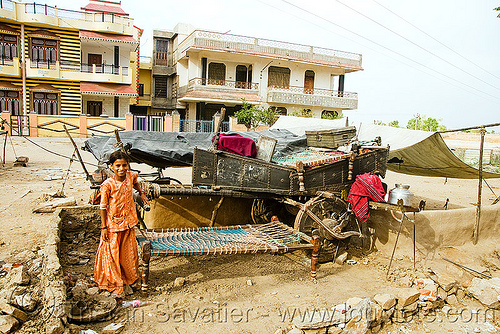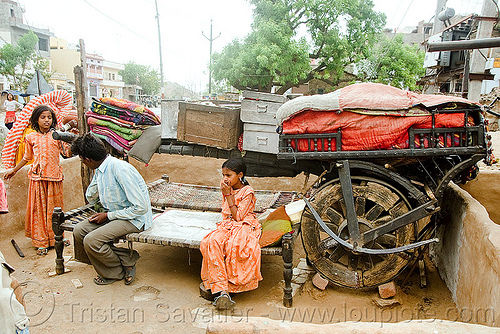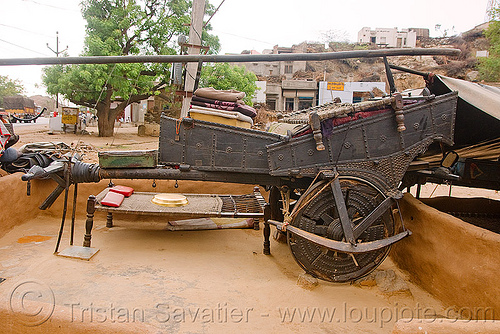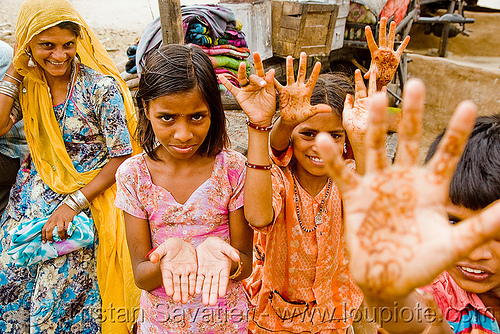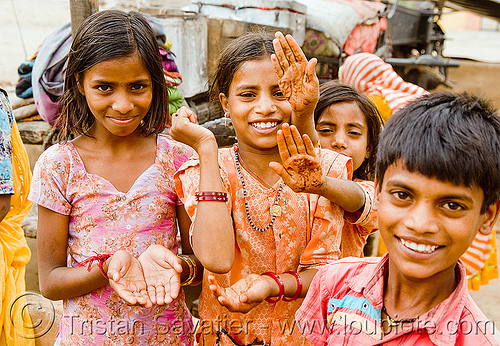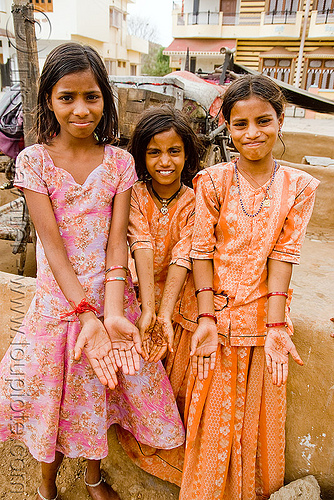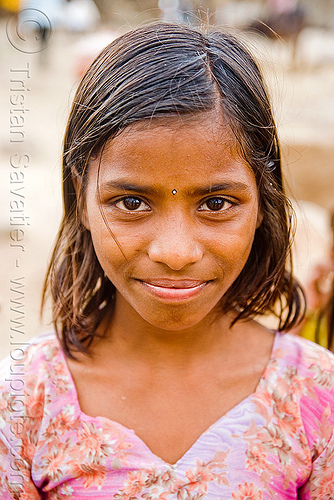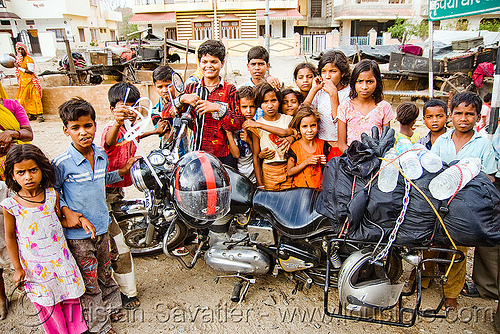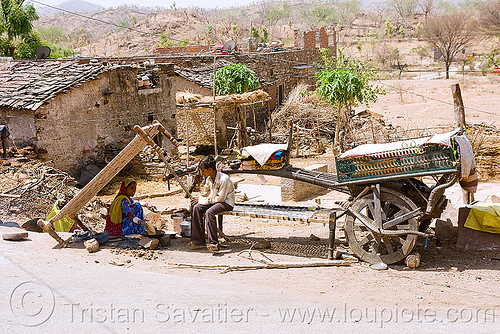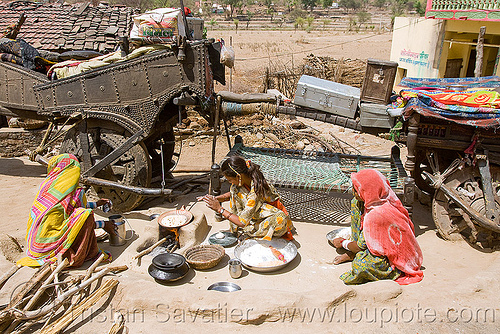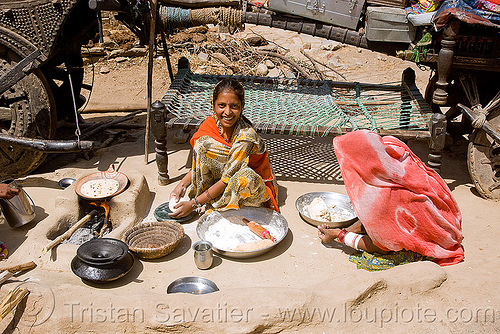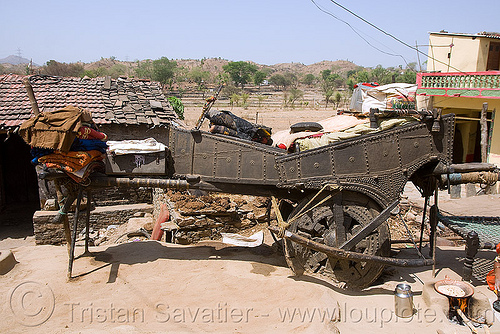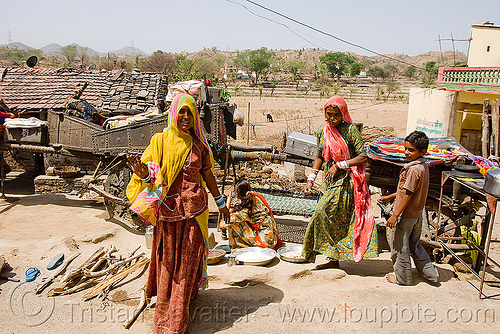gadia lohars nomadic tribe (india) - 13 photos
Photos of Gadia Lohars Gypsy people in India.
Gadia Lohars people (also known as Gaduliya Lohars or Wanderer Blacksmiths) have very particular Oxcarts that appear to be very old and decorated with many nails, that are parked along the road in villages. They camp / live under their oxcarts. They built small mud walls around their oxcarts, and some appear to have been camping at the same location for several months - yet they prefer camping under their oxcarts rather than build a house.
I saw similar camps in many villages in Rajasthan. Those people don't like to be photographed, and unlike other poor people i saw in India, they beg for money, so it is difficult to take photos of them. They sometimes ask money to allow people to take photos of them or their oxcarts.
There is a short wikipedia article about the Gadia Lohar tribe: en.wikipedia.org/wiki/Gadia_Lohar .
National Geographic published a story about India's Lost Nomads that talks about the Gaduliya Lohars tribe.
I also found a very interesting article about the Gaduliya Lohars nomadic tribe by Esteban Cobas Puente in UNESCO Courier, Oct 1984.
Below is a copy of this article (in case the original article above becomes unavailable):
The Gaduliya Lohars: India's wandering blacksmiths
RESEARCH in linguistics, anthropometrics, ethnology, and other fields has conclusively established the Indo-Aryan origin of the Gypsies. But the precise nature of the kinship between the Gypsies as we know them in different parts of the world and the various groups which live in northwestern India has not yet been determined. One nomadic group, the Gaduliya Lohars of Rajastan, has attracted attention from Indian and European specialists because of the many similarities observed between its members and those of other groups which have been studied in Europe. These similarities occur in language, family and social structures, dress, and certain forms of popular literature and folklore.
Lohar means "smith", and Gaduliay is the name given to the distinctive type of oxcart used by this group. The term Gaduliya Lohar may thus be translated as "wandering smith", as distinct from the sedentary Hindu smiths belonging to the maru and malviya castes who live in the same region. This dual status of smith and nomad determines their place in India's complex social system.
Rajastan is the region of origin of the Gaduliya Lohars, and they claim to belong to the famous Rajput group. Many orally transmitted accounts agree on this point. The present-day Gaduliya Lohars are descended from groups which served the Rajput princes, for whose armies they made and serviced weapons. Consequently, they enjoyed special esteem and consideration until 1567-1568, when the repeated assaults of the emperor Akhbar overcame the seasoned defenders of the Fort of Chittorgarh, bringing the Rajput dynasty to an end.
The defeat of the arms manufactured by them was felt by the Lohars as a serious blow to their reputation, and they swore to give up this traditional activity until the dishonour was repaired, devoting themselves in the meantime to the peaceful manufacture of domestic utensils and agricultural implements. In order to avoid conflit with smiths belonging to other castes who were already established in the large centres of population, they decided to take to the roads and serve towns and villages far from the main highways.
To cover the great distances involved, it was necessary to adapt the traditional cart of the region and create a model--the gaduliya--that would meet their new requirements. This model, created in the sixteenth century, can still be seen today on the roads of northern India. The original size and layout of the interior, used to store utensils, tools, and food, have not changed, although nowadays the cart is used only for transport and no longer as a dwelling as in the case of other nomad groups.
The gaduliya is made from kikar (Acacia Arabica) wood, and is stronger and heavier than other types of cart. Its peculiar features are the thalia and the pheechla. The former is a fairly spacious triangular chest which forms the forepart of the cart. The middle and rear parts, which are uncovered, constittute the pheechla, to which side panels are attached. The carts are built only by a small number of craftsmen who are established at Gangura for the north and west of the region, and at Barmer for the south and east.
The side panels, or pankhalas, the outside of the chest, and the wheels, are the only surfaces which the owner can decorate to give a distinctive aspect to his gaduliya. This decoration consists of bronze plates fixed to the wood. Those which cover the side panels are invariably divided into four sections, each containing sixteen compartments, and it is by means of the motif chosen to decorate each of these compartments that the family gives a distinctive appearance to its vehicle. These motifs include squares, lozenges, stars and stylized flowers. The long shaft by which the oxen are attached to the cart is decorated with plaited strips of buffalo hide.
The gaduliya is the real centre of family life. All the family belongings are stored there according to an unchanging order. In the triangular chest in front, the small door of which can be locked for security, are kept cash, jewels when not being worn by the women, gold, sweetmeats, solidified butter, needles and thread,the looking-glass, kohl and other cosmetics. In a word, the thalia is the family treasure chest. In the open part of the vehicle sacks of rice, lentils and flour are placed in the centre, while domestic utensils are placed on one side and the smith's tools on the other. The family clothing is stored between the sacks and the thalia.
As soon as a camp has been established, family life takes place exclusively around and under the cart; matting provides protection from sun and rain.
The new activities of the Lohars after the defeat of Chittorgarh must have been influenced by the nature of the environment in which they found themselves. They must have had to devise a balanced economic system based on the relationship between man and nature, between the natural and the artificial in a region like Rajastan where natural conditions and features can vary sharply from area to area and from season to season. For instance, the rainy season puts a stop to nomadism, and so fixed camp sites were established for the Lohar groups. Even today the Lohars still stay at these sites, known as thiya, every year from mid-May to mid-September. The period from May to July is devoted to rest, visits, weddings, and meetings of the group's ruling council. From July to September visits are made to local livestock fairs to purchase draught animals.
The remaining eight months are spent travelling, according to a pattern which has not changed since the sixteenth century and which enables each group to cover a particular part of the region. Every group has established relations with the peasants in its area, and these relations have been kept up by both sides for generations.
Life for the Gaduliya Lohars is lived mainly within the group. They do not stay long in populated centres. Much of their time is spent travelling, and contacts with individual peasants or peasant groups tend to be brief. This explains how they have managed to preserve their customs unchanged since they decided over 300 years ago to devote themselves to the service of agriculture. Their style of dress, their jewellery, even the men's hairstyles, have scarcely changed over the centuries. The same goes for their family customs, and their birth, wedding and funeral rites.
In the cultural mosaic of India, the Gaduliya Lohars occupied a distinctive place in Rajastan; they were accepted as an essential factor in the region's social and economic structure. They were not in competition with sedentary smiths. Each group had its own clientele. This situation prevailed for more than 300 years until in this century large-scale industry began to alter the pattern of India's economy.
The impact was such that many groups of Gaduliya Lohars were obliged to abandon their traditional circuits and sought new customers in other areas. It was a severe test for a nomadic smith to have to compete with other nomadic or sedentary smiths from neighbouring areas, to give up old connexions, and above all to face the risk of coming into contact with other cultural models which were powerful enough to undermine his group's stability. The roads westward lead to the desert regions of the Sind, which are ill-suited to agriculture. The only practicable route led eastwards, where lay prosperity and promise. Many groups migrated in this direction; others stuck obstinately to the old circuits. The latter have suffered greatly from the changes which the invasion of the market by mass-distributed industrial products has brought to the region's economy.
During the past two or three decades attempts have been made by the authorities to solve the problem. As in other times and in many other places, the solution proposed was the sedentarization of the nomad. The Indian socioligist Professor Satia Pal Ruhela, a leading authority on the Gaduliya Lohars, has made a detailed study of official plans for "rehabilitation" by means of "colonies" established on permanent sites in the territory. He explains why most of these attempts have failed. He found evidence of ignorance or neglect of the psychological factors inherent in the nomadic character of the group, as well as of the mythological factors associated with the dwelling and the orkshop. Above all, the balance of a number of social and cultural factors such as the internal cohesion of the groups and families was destroyed by their dispersal and by indiscriminate distribution of land in an attempt to transform them into farmers overnight.
Other Gaduliya Lohar groups which have gradually decided to modify and extend their circuits have entered into direct contact with other cultures and groups, and learned new techniques from them which have enabled them to improve and even expand their production of handmade goods, to their economic advantage.
The acculturation process which is an inevitable consequence of these contacts is reflected in a number of changes in the life style of the Gaduliya Lohars, some of which are very striking. The style of dress, especially for women, has been changing, becoming adapted to the new environment. Men, too, are changing their appearance by, for instance, adopting a less traditional hairstyle.
Faced with a hard struggle for survival, those who have remained faithful to the traditional circuits are also finding it difficult to preserve all their traditions, whether they be the decoration of their vehicles or the feasts and ceremonies of their traditional calendar. The situation is one which is not, unfortunately, confined to the Gaduliya Lohars. A social group is faced with a terrible dilemma when it has to decide whether to remain faithful to its traditions and risk the very survivial of its members as a group, or to abandon these traditions and expose itself to all the risks of acculturation but ensure a level of economic well-being that satisfies its members' needs.
The solution dos not seem to lie in either of the two relentless alternatives--to continue being Gaduliya Lohars and die slowly, or to cease being Gaduliya Lohars and survive. Between these two extremes there is a broad area full of possibilities which should be explored and exploited in order to save the cultural identity of those concerned. The benefit will not be for them alone. When a social group prospers and lives an active life, the whole of society benefits thereby.
COPYRIGHT 1984 UNESCO
COPYRIGHT 2004 Gale Group
